Art directorate and design
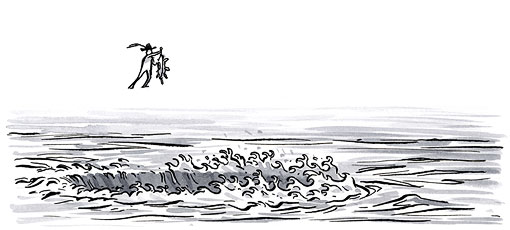
Illustration by Kevin Cornell
The imminent appearance of
Translation: Randall Roffe
Translation sponsor: Aiken Studio
Art directorate is not blogazine
A popular article, The Death of the Blog Post, talks about a “blog journal,” a mix of journal articles and blog posts. The article states: outstanding designers said a new word and began to make the concept of "
')
Magazines are not just created for the individual design of articles. Their goal is to combine the visual image and text to enhance the expressiveness of the narrative. A variety of designs are the result of this aspiration, and not just diversity for the sake of diversity. In the staff of the magazine,
To transfer this process to the practice of
What is what
Artistic leadership brings clarity and certainty; it helps our work to transmit a certain signal to a specific group of people.
By contrast, design is the technical realization of this connection. Are these colors combined? Is the length of the text line convenient for long reading? Is the photo cutting? Does typographical hierarchy work? How well balanced is this composition?
If I tell my wife that I love her, but I do it with a frowning face, her impression will be ambiguous. If I say this indifferently, looking at the TV, she just won't believe me. But when I say this with a sincere smile and a bouquet of flowers - my thought is clear. In this example, my love is
Here are some tips on approaches to design and artistic oversight, as you understand the difference between them in your work:
Distinctive approaches to
| TOOL | ART DIRECTOR | DESIGN |
| Colour | Is this color scheme suitable for this brand? Does it fit the situation? Bright colors may not be appropriate for the sad message. | Do these colors look good together? Do they play? Is each color the best choice for a given environment, for example, the “Pantone” color set for printing? |
| Why did you choose this font? How does the form of letters convey meaning without the words themselves? Comic Sans may be too ridiculous, and Helvetica may be too boring. | Does my set of font sizes create the necessary visual hierarchy? Is the font sufficiently saturated for it to be used in this context? | |
| Composition | How balanced should this composition be? Balanced compositions are pleasant, but often passive. Unbalanced compositions are often unstable and cause anxiety, but visually they are more interesting. | Do I have even fields? Is there a natural rhythm in the images that will guide the eye through the whole piece? |
| Concept | How well do visual elements support and convey the mood of the brand? What signal or what theme is the design? | How well do visual elements fit the brand’s recommendations for logo placement, appropriate printing and color schemes? |
| Generally | Does this create the right mood? | Does it look good? |
Don't take my word for it
I asked several of my friends to comment on the differences between design and
“Design refers to solving problems, regardless of whether you are a designer orart director . These two roles are distinguished by the fact that the designer is more concerned about the performance, while theart director is more concerned about the strategy underlying this performance. ”
- Springboxart director Phil Coffman
“Design is“ how ”, it is the basis of communication, the process and execution of print, color, scale and placement.The art director is “why”, this is the concept and solutions that will wrap the whole product. Beyond this is participation, sensation and politics. ”
- SeniorArt Director of “ Big Spaceship ” Jarrod Riddle (Jarrod Riddle)
“The function of design is different from the function ofart directorship .Art directors are expected to provide a concept. Designers are expected to implement the idea and implement the concept. However, it is very important to remember that they almost never differ as black and white. Designers function asart directors , andart directors design. Based on my experience, this process occurs in close cooperation. Ideas fill the concept and vice versa. ”
- Design Director " Gridplane " DD Hudge (JD Hooge)
“Art directorship is a decision filter; through it you miss any design choice. Begin by defining a general state of mind. Everything - text, photography, user interface elements and even the kitchen sink should be checked against the ideal. I like to present it as a magical kaleidoscopic mirror. It helps to determine which direction I should take, making difficult decisions in design. ”
- Creative Director of “ Happy Cog ” Christopher Cashdollar
Three hats
I once taught graphic design at the University of the Arts in Philadelphia. In the room, which I borrowed from the creative director of Happy Cog, Christopher Cashdollar, I wanted to arrange for students to choose strips of paper from each of the three hats. In the first hat there were leaves with tasks, in the second hat there were leaves with various design elements, and in the third hat there was
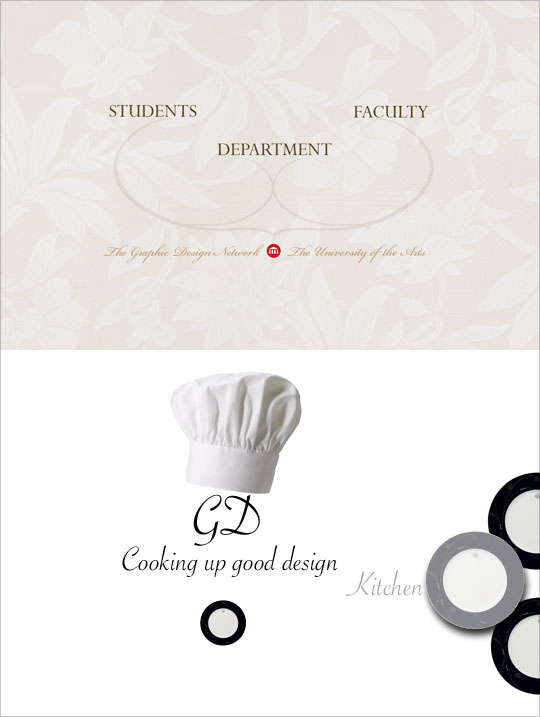
Fig. 1. The stereotypical approach to explaining the difference between
This is rather a theoretical rather than a practical exercise, but for students it began to develop a sense of which combinations are more natural: bright colors are more natural when working with “happy” works. A typographic set, for example, is a design element that naturally gives a sense of a properly designed work.
It is also important that students begin to understand the special, exciting possibilities of unusual combinations. How can you create a “happy” website with dark colors? You can create a unique style of illustration that combines “happiness” and dark colors! How can I make a proper type of brochure without a proper typographic headset? Try a moderate sized light serif font on a dark background with ornaments. Although these are stereotypical examples, the students developed a sense of how to make the world around them see what they wanted him to see (and this even in spite of working in a rigid framework).
Bad design, good art direction
Search for the image for the term " happy birthday ". You will find some of the most horrific design crimes ever committed: very aggressive color combinations and repulsive print.
Yes, they all convey the essence: fun, celebration and happiness. Most of them have a bad design, but we all know internally how
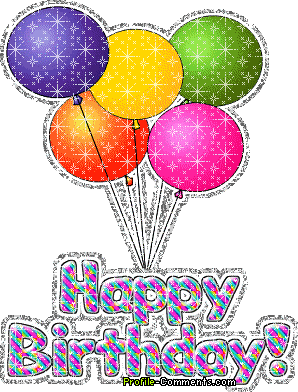
Fig. 2. From this design, I cry with bloody tears, but
Regarding art directors
Large differences in the role of
Many small agencies for various reasons do not hire
In his brilliant book “
“Art directors should carry out one fundamental activity - they should direct. If they do not, they are notart directors . Although this should not imply thatart directors should be arrogant or tough, in fact this means that they have a “divine right of expertise.”The art director may not always have the last word ... but he or she must remain the final arbiter of art and design. The first rule is decision making, the second is making the right decision ... “
“Everyart director should start with the belief that his or her job is to lead, not follow.” To guide, rather than be guided, to be, as far as possible, an influential figure, and not to take the position of least resistance. ”
See and feel
Once I took part in a project in which several designers sold independent concepts to the same client. Built on the freelance model, our work was non-hierarchical, more complementary than competitive, but we often lacked a common look at each project.
Each designer was responsible for
Many consider the words “to see” and “to feel” synonymous with using them one instead of another. Creating a design is creating a “look”. “Feeling”, however, requires special attention from an experienced
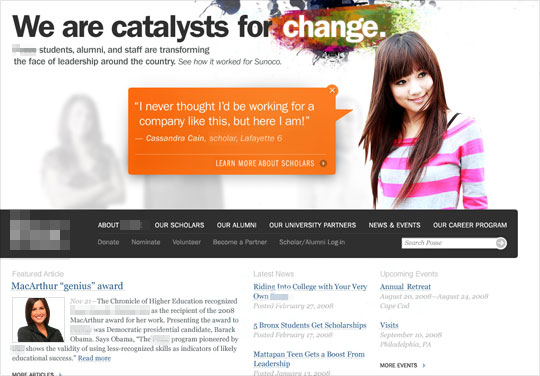
Fig. 3. Thank God, the client had the wisdom to reject my page layout. While the design can be well executed - rich typography, a harmonious combination of colors, a strict grid, a dynamic composition -
Today, the
“Once a month, once a week, even once a day - this is the frequency of updating the printed edition. Now everything is not so - the digital edition is updated as quickly as possible, it is updated constantly. This is not a person's rhythm, this is a machine rhythm, and it makes excessiveart directorship economically unprofitable. ”
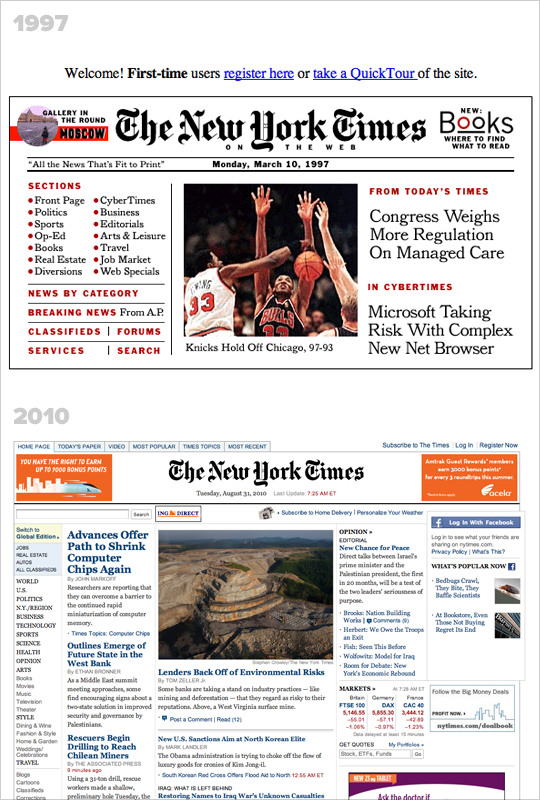
Fig. 4. With a minimal
Appreciating moments
Today we do not apply
“I realized the power of the actual creation of the moment: the moment of pause, the moment of reading, the moment of deliberation. In any song, in any work of art you cannot use only high notes. You need to create moments when people can listen to it and experience excitement. It is even necessary to include moments of silence in your work. ”
It is here that
Well done
We have defined the concept of

Fig. 5. Site form (Launchlist): a winning combination of
Let's take a look at the Launchlist site and its launch form. The launch metaphor of the space shuttle informs us about the decisions behind the feeling, appearance and messages. A sky-like background and slow moving clouds are by no means an arbitrary choice. The combination of metallic interface colors resembles a real control panel. Smart sliders (yes / no) instead of tick boxes give the feeling that you are performing a process, and do not switch the browser elements used by default. The type of messages, including “launch not recommended” or “launch!” Enhances the simulated space flight control environment. All the details reinforce the impression.
This is a wonderful example of
Changes life
When my grandfather died, I wrote about it to my friends. I wanted to share my memories of his life. I was thinking about
I had a system on my site — hard stencils that did not give much flexibility, so I worked within these limits. Instead of creating large tabloid-like headings, as I usually do, I carried out the title with restraint in small capitals and increased the amount of space around the font. I did not need to do
I did not want to change the design for the design itself. I wanted my readers to understand how special my grandfather was to me. I wanted to convey my thoughts and feelings as much as possible and thereby
Translated by Aiken Studio specifically for dear Habrahabr readers.
Source: https://habr.com/ru/post/115351/
All Articles